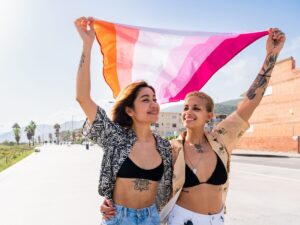With the ‘Y2K’ aesthetic having cemented itself back into the wardrobes and onto the feeds of everyone’s favourite social media app, it’s unsurprising that the revival of these fashion trends has also brought back the worst parts of the 2000s, the ones that we swore to never return to.
Wearing our rose-tinted glasses and ultra-low-rise jeans, the glamourisation of the noughties has led to a new generation forgetting about the dark side of being a young woman in this era. At the surface level, you see Juicy Couture tracksuits, bedazzled baby tees and crimped hair, however, I would argue that by simplifying the time to its appearance, it’s easy to forget about the unrealistic beauty standards reinforced by the style.
Now, you might ask, ‘Well, clothes are clothes, how can some fabric perpetuate a beauty standard?’ I see that the clothes are an accessory to the truest trend of the time, to be dangerously skinny. We’ve come so far in reinforcing the message that all bodies are beautiful and that being healthy – no matter your weight – is the ideal, yet when it comes to romanticising the early 2000s, the ideal always centres back on how a woman looks beneath her clothes.

With brands like Victoria’s Secret hosting a parade of beautiful, tiny white women as their models during their annual fashion show, the selling point of these shows is not the lingerie, but the culture around the wider event. People didn’t tune in to see the latest style of bra for sale, they tuned in to see the drop-dead-gorgeous models wearing the outfits. As a young teen, I remember seeing a clip from the 2006 show, where Justin Timberlake was performing Sexyback. Going back and recalling the clip now, I couldn’t tell you what any specific model was wearing, but I do remember Gisele Bündchen‘s fierce walk down the runway and the way that she looked wearing the clothes.
The selling point of many celebrities and models of the era wasn’t even down to the way they looked, but how little they weighed. With size zero model Kate Moss popularising the pro-anorexia mantra that “nothing tastes as good as skinny feels” coinciding with the conversation around the ‘heroin chic’ appearance held by many models, it’s no surprise that this all contributed to the skinny worship.
Yet, unrealistic body image standards aren’t the sole concern around the revival of noughties fashion, as many of the trends we have seen return to clothing stores in recent times have undoubtedly been influenced by Black people and Black culture. With artists like Lil Kim, a rapper acknowledged as a pioneer of fashion in the early 2000s, popularising trends like ‘McBling’ with her outlandish style.

Giving credit where credit is due is a must for any creative, so why is it that Black culture is continually reworked and credited elsewhere? Shelby Hyde discusses the origins of many trends which have been revived today, and I found her conversation around name-plate necklaces to be particularly interesting. Sex and the City’s leading character, Carrie Bradshaw, described her gold jewellery as ‘ghetto gold’, with her monogram necklace having already been worn by thousands of young Black women across the US. Clothing brands continue to popularise the Y2K aesthetic, so they must be careful in the not excessively romanticising the era they are chasing without equally considering the steps we have taken in body positivity and cultural representation.
The representation we continue to see on screen is still deeply rooted in the 00s beauty standards, despite the hard work of activists and campaigners over the past decade. However, the general public’s opinions on ‘super-skinny’ models is becoming much more critical, with model Bella Hadid often being seen as the modern-day equivalent of Kate Moss. With a viral post being shared by X user freshhel shows that women are becoming tired of the tropes that once dominated the media so heavily and frequently encouraged disordered eating for the sake of ‘beauty’.
But it’s not just celebrities, like Hadid, that are co-opting this fashion for the sake of trend-following, brands like Brandy Melville, known for their one-size clothes, are using the return of noughties fashion to begin to push the idea that there is an ideal body type, and it’s skinny.
The work of academics Mehdi and Frazier argue that the body positivity movement has been twisted by brands in the fashion industry. They argue that the movement, once built to empower those with bodies that were not considered ‘acceptable’, has now been overtaken by the promotion of body types that were never under question. I’ve seen hundreds of comments from people defending businesses like Brandy Melville, using the argument that skinny people deserve nice clothes too, yet that idea was never under question. Many brands already cater to those at a size 6, but not to those who are a size 24, an argument futile when they are, once again, excluding marginalised people for the sake of profit.
This whole conversation, stemming from the return of the fashion trends once popular at the turn of the millennium, leads me to question, did we ever stray far from the trends we once swore to never return to? And ultimately ask, how did we end up here again?













